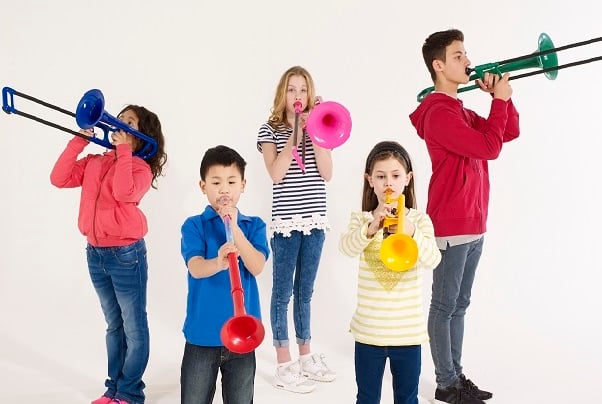


The story is a common one:
“We are a low-income title school with major poverty. We are in the process of rebuilding the band program. I have tested 41 students for the beginner band this year. “These kids want to play but many will not be able to because of money. We have some loaner instruments available for students to borrow, but there is never enough to go around. “The instruments I can check out to students such as trombones and trumpets are very old and generally trashy.”
These are actual comments made by music teachers time and again. Made so often that we may tend to stop listening.
But if we did listen, we would hear issues of equity:
Sometimes instrumental music class is the only reason a child goes to school – but when fully functioning instruments are not available, what then? That’s the story which is worth your time.
Your district is not alone. It is a systemic problem. Many school districts, especially those designated for Title 1 funding, have the same issue. Even overseas, the United Kingdom's education system has designated certain musical instruments as “endangered” because of the lack of quality instruments for students who want to learn. For those children, the answer is “no.”
For most, the answer is not "No, we won't." Instead, it's "no, we can't". Even with extraordinary federal funding, the financial cost to purchase and maintain traditional band instruments is just too much to bear.
In the UK, a big part of the answer was provided by musicians and band teachers who saw there was a better way. Today, more students in both the U.S. and the UK, and around the world, can start their instrumental music learning with a “pJourney” and receive the music education benefits every child deserves.
What is the pJourney?
Like most learned subjects, music education should be on a continual plane, building on previous learning experiences. The pJourney is a continual music plane using “pInstruments”; a series of high-quality, long-lasting, and affordable music instruments – pBugle, pBuzz, pBone Mini, pTrumpet, and pBone – all made from plastic. There is even a metal and plastic hybrid trumpet (pTrumpet hyTech), that looks better and plays better than many of the school-provided instruments in your current music programs.
So what’s a pJourney? It’s a learning curriculum that starts in the second grade with the pBugle. A trumpet without valves, the pBugle is intended for exploration in music: learning to make a sound, understanding pitch, listening, call and response, and group participation. The instruments are simple, durable, easy to clean, and even fully recyclable after years of use.
In third grade, the pBuzz is introduced. The pBuzz has a range of just six notes through a moveable slide. Slide positions are outlined by color, note name, and positions. Auditory, visual, and kinesthetic learning are on full display as students are actively expanding their musical abilities. Every basic music skill is introduced so that no matter what musical genres students choose in the future, their basic music skills are already well-learned. For more advanced learners, including the pBone Mini will help them progress even further as it combines both the pitch skills learned with pBugle with the notes and positions of the pBuzz. While not technically a band instrument, the pBoneMini is an actual trombone, in “mini” size.
Many teachers present their “instruments of the band and orchestra” curriculum in the 4th grade. This often includes seeing the instruments, hearing the instruments, and maybe even touching the instruments. Some, however, introduce the instruments by having students learn to play the instruments. pInstruments are affordable and built to stand the wear and tear a student classroom can give out. No dents, no dings, and especially no instruments out of service due to damage. pInstruments are not indestructible, but they are close!
Students on the pJourney will take to these instruments very well and the group dynamics and cooperation are on full display as they help each other learn by watching, listening, and helping each other succeed.
These same instruments are also incorporated into groups such as Mariachi and Modern Band. Then, as students move forward in their music choices, they will have a better understanding of basic music skills that can be transferred into band, orchestra, choir, or other music programs available to them.
The need for equity in school music is easy to spot. Students are discouraged when the opportunity is not available to them. There are answers. The incorporation of pInstruments into your music classrooms is possible. All it takes is one first step.
To receive additional help in assessing your school's or district's needs, please take this short survey.
Rich grew up on Chicago’s south side and attended Marist High School, where he was an active member and drum major of the school’s marching band. He attended Elmhurst College (University), receiving a degree in marketing and music-business. His early career included time at the Chicago Symphony and Ravinia Festival organizations, as well as classes at the Chicago-Kent College of Law. Rich’s career has been dedicated to music education. He has worked closely with educators, professionals, retail businesses and corporations. He has established key education partnerships and has served on the board of directors for several non-profit education organizations. He has provided executive planning and marketing acumen for 21st century companies through Strategic Marketing Management, LLC since 2011. Prior to opening his own firm, he served in key management roles at KHS America, Inc., the Conn-Selmer division of Steinway & Sons, Inc., and United Musical Instruments, all worldwide manufacturers and distributors. He served in the management of the SMART Foundation which provided programs and advocacy support for arts education. He has also authored several publications focused on the arts and education and has served on the boards of non-profit music education organizations.